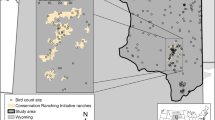Abstract
Alternative ways to apply the guild concept to wildlife management are evaluated here. I reject the idea that indicator species can be selected for each bird guild to reduce costs of environmental assessment and monitoring. Promise is seen, however, in the option of using whole guilds to indicate the capability of habitat zones to support populations of wildlife species. It may be adequate for most management purposes to delineate guilds only for species that use an environment for breeding, because transients and winter residents probably use the same zones of the habitat in the same ways. Potential guilds are identified by cells of a two-dimensional matrix, the axes identifying primary feeding and nesting zones. Some questions may be answered with guilds as delineated by all cells in the matrix. Alternatively, larger guilds can be formed by grouping all species in each column or row of the matrix to identify, for example, all species that depend on tree canopies for foraging, or tree boles for nesting. One can also consider separately the resident breeders, migrant breeders, and winter residents to obtain insights into whether observed changes in numbers of birds in a guild are a result of conditions locally or elsewhere. I conclude that the guild concept probably has a place in wildlife management, but much testing must be done before it is widely applied.
Similar content being viewed by others
Literature cited
Balda, R. P. 1975. The relationship of secondary cavity nesters to snag densities in western coniferous forests. USDA Forest Service, SW Region, Albuquerque, NM.Wildlife Habitat Technical Bull. 1:1–37.
Beal, F. E. L. 1910. Birds of California in relation to the fruit industry. Part II.USDA Biol. Survey Bull. 34:1–96.
Beedy, E. R. 1982. Bird community structure in coniferous forests of Yosemite National Park, California. Ph.D. dissertation, University of California, Davis, CA. 167 pp.
Crome, F. H. J. 1978. Foraging ecology of an assemblage of birds in lowland rainforest in northern Queensland.Australian Journal of Ecology 3:195–212.
Dawson, D. G. 1981. Experimental design when counting birds. Pages 392–398in C. J. Ralph and J. M. Scott (eds.), Estimating numbers of terrestrial birds. Studies in Avian Biology 6.
DeGraaf, R. M., and J. M. Wentworth. 1981. Urban bird communities and habitats in New England.Trans. N. Amer. Wildl. and Natur. Resourc. Conf. 46:396–413.
Dueser, R. D., and H. H. Shugart, Jr. 1979. Niche pattern in a forest-floor small-mammal fauna.Ecology 60:108–118.
Duncan, D. A., and W. J. Clawson. 1980. Livestock utilization of California's oak woodlands. Pages 306–313in T. R. Plumb (tech. coord.), Proceedings of Symposium on the Ecology, Management, and Utilization of California Oaks. USDA Forest Service, Gen. Tech. Report PSW-44. PSW Forest and Range Exp. Stn., Berkeley, CA.
Folse, L. J., Jr. 1981. Ecological relationships of grassland birds to habitat and food supply in east Africa. Pages 160–166in D. E. Capen (ed.), The use of multivariate statistics in studies of wildlife habitat. USDA Forest Service, Gen. Tech. Report RM-87. Rocky Mountain Forest and Range Exp. Stn., Fort Collins, CO.
Haapenen, A. 1965. Bird fauna of the Finnish forests in relation to forest succession. I.Annales Zoologici Fennici 2:153–196.
Hejl, S. J. 1981. Foraging ecology of birds in relation to plant phenology in California pine-oak woodlands. M.S. thesis, University of California, Davis, CA. 73 pp.
Holmes, R. T., R. E. Bonney, Jr., and S. W. Pacala. 1979. Guild structure of the Hubbard Brook bird community: a multivariate approach.Ecology 60:512–520.
Jaksić, F. M. 1981. Abuse and misuse of the term “guild” in ecological studies.Oikos 37:397–400.
Järvinen, O., and R. A. Väisänen. 1979. Changes in bird populations as criteria of environmental changes.Holarctic Ecol. 2:75–80.
Johnson, R. A. 1981. Application of the guild concept to environmental impact analysis of terrestrial vegetation.J. Environ. Manage. 13:205–222.
Landres, P. B. 1983. Use of the guild concept in environmental impact assessment.Environ. Manage. (in press).
Landres, P. B., and J. A. MacMahon. 1980. Guilds and community organization: analysis of an oak woodland avifauna in Sonora, Mexico.Auk 97:351–365.
Leopold, A. 1953. Round River. Oxford University Press, New York, NY. 173 pp.
MacMahon, J. A., D. J. Schimpf, D. C. Andersen, K. G. Smith, and R. L. Bayn, Jr. 1981. An organism-centered approach to some community and ecosystem concepts.J. Theor. Biol. 88:287–307.
MacRoberts, M. H., and B. R. MacRoberts. 1976. Social organization and behavior of the Acorn Woodpecker in central coastal California.Ornithol. Monogr. 21:1–115.
Martin, T. E. 1981. Limitation in small habitat islands: chance or competition?Auk 98:715–734.
Maurer, B. A., L. B. McArthur, and R. C. Whitmore. 1981. Effects of logging on guild structure of a forest bird community in West Virginia.American Birds 35:11–13.
Raphael, M. G. 1980. Utilization of standing dead trees by breeding birds at Sagehen Creek, California. Ph.D. dissertation, University of California, Berkeley, CA. 195 pp.
Root, R. B. 1967. The niche exploitation pattern of the Blue-gray Gnatcatcher.Ecol. Monogr. 37:317–350.
Severinghaus, W. D. 1981. Guild theory development as a mechanism for assessing environmental impact.Environ. Manage. 5:187–190.
Short, H. L. 1982. Development and use of a species richness model to evaluate wildlife habitat.Trans. N. Amer. Wildl. and Natur. Resourc. Conj. 47:57–72.
Short, H. L., and K. P. Burnham. 1982. Technique for structuring wildlife guilds to evaluate impacts on wildlife communities. USDI Fish and Wildlife Service, Special Sci. Report—Wildlife 244. 33 pp.
Siegel, S. 1956. Nonparametric statistics for the behavioral sciences. McGraw-Hill, New York, NY. 312 pp.
Siegel-Causey, D., and T. S. Whittam. 1980. Species associations and community structure in Alaskan seabird colonies.Amer. Zool. 20:883 (abstract).
Thomas, J. W., R. J. Miller, C. Maser, R. G. Anderson, and B. E. Carter. 1979. Plant communities and successional stages. Pages 22–39in J. W. Thomas (tech. ed.), Wildlife habitats in managed forests: the Blue Mountains of Oregon and Washington. USDA Forest Service, Agric. Handbook No. 553.
Verner, J. 1980a. Birds of California oak habitats-management implications. Pages 246–264in T. R. Plumb (tech. coord.), Proc. of Symposium on the Ecology, Management, and Utilization of California Oaks. USDA Forest Service, Gen. Tech. Report PSW-44. PSW Forest and Range Exp. Stn., Berkeley, CA.
Verner, J. 1980b. Bird communities of mixed-conifer forests of the Sierra Nevada. Pages 198–223in R. M. DeGraff (tech. coord.), Workshop Proceedings: Management of Western Forests and Grasslands for Nongame Birds. USDA Forest Service, Gen. Tech. Rep. INT-86. Intermountain Forest and Range Exp. Stn., Ogden, UT.
Woolfolk, E. J., and J. N. Reppert. 1963. Then and now: changes in California annual-type range vegetation. USDA Forest Service, Research Note PSW-N24, PSW Forest and Range Exp. Stn., Berkeley, CA. 9 pp.
Author information
Authors and Affiliations
Rights and permissions
About this article
Cite this article
Verner, J. The guild concept applied to management of bird populations. Environmental Management 8, 1–13 (1984). https://doi.org/10.1007/BF01867868
Issue Date:
DOI: https://doi.org/10.1007/BF01867868




